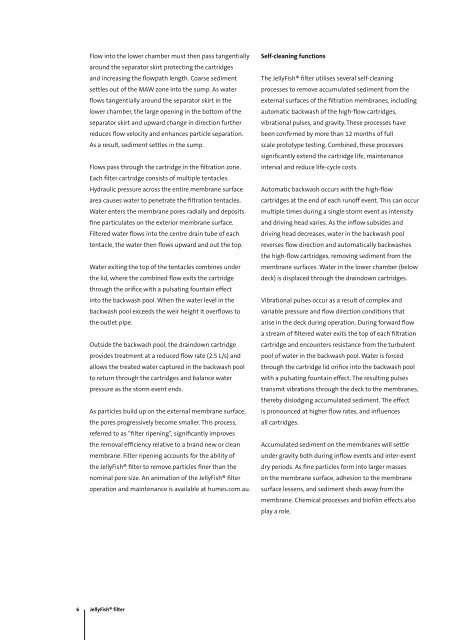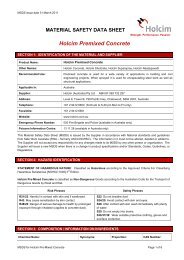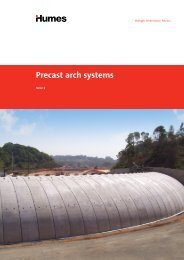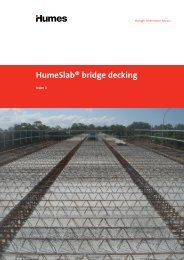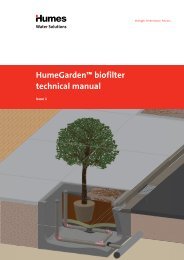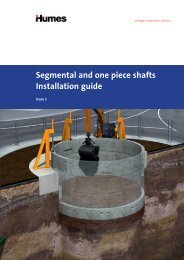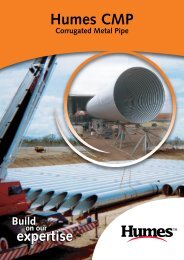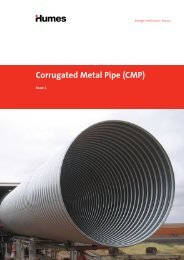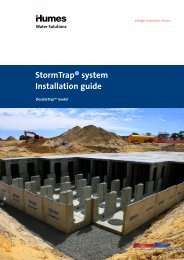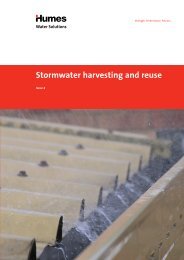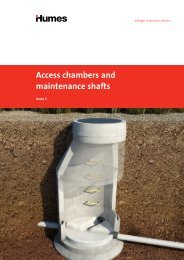JellyFish® filter technical manual - Humes
JellyFish® filter technical manual - Humes
JellyFish® filter technical manual - Humes
Create successful ePaper yourself
Turn your PDF publications into a flip-book with our unique Google optimized e-Paper software.
Flow into the lower chamber must then pass tangentially<br />
around the separator skirt protecting the cartridges<br />
and increasing the flowpath length. Coarse sediment<br />
settles out of the MAW zone into the sump. As water<br />
flows tangentially around the separator skirt in the<br />
lower chamber, the large opening in the bottom of the<br />
separator skirt and upward change in direction further<br />
reduces flow velocity and enhances particle separation.<br />
As a result, sediment settles in the sump.<br />
Flows pass through the cartridge in the filtration zone.<br />
Each <strong>filter</strong> cartridge consists of multiple tentacles.<br />
Hydraulic pressure across the entire membrane surface<br />
area causes water to penetrate the filtration tentacles.<br />
Water enters the membrane pores radially and deposits<br />
fine particulates on the exterior membrane surface.<br />
Filtered water flows into the centre drain tube of each<br />
tentacle, the water then flows upward and out the top.<br />
Water exiting the top of the tentacles combines under<br />
the lid, where the combined flow exits the cartridge<br />
through the orifice with a pulsating fountain effect<br />
into the backwash pool. When the water level in the<br />
backwash pool exceeds the weir height it overflows to<br />
the outlet pipe.<br />
Outside the backwash pool, the draindown cartridge<br />
provides treatment at a reduced flow rate (2.5 L/s) and<br />
allows the treated water captured in the backwash pool<br />
to return through the cartridges and balance water<br />
pressure as the storm event ends.<br />
As particles build up on the external membrane surface,<br />
the pores progressively become smaller. This process,<br />
referred to as “<strong>filter</strong> ripening”, significantly improves<br />
the removal efficiency relative to a brand new or clean<br />
membrane. Filter ripening accounts for the ability of<br />
the <strong>JellyFish®</strong> <strong>filter</strong> to remove particles finer than the<br />
nominal pore size. An animation of the <strong>JellyFish®</strong> <strong>filter</strong><br />
operation and maintenance is available at humes.com.au.<br />
Self-cleaning functions<br />
The <strong>JellyFish®</strong> <strong>filter</strong> utilises several self-cleaning<br />
processes to remove accumulated sediment from the<br />
external surfaces of the filtration membranes, including<br />
automatic backwash of the high-flow cartridges,<br />
vibrational pulses, and gravity. These processes have<br />
been confirmed by more than 12 months of full<br />
scale prototype testing. Combined, these processes<br />
significantly extend the cartridge life, maintenance<br />
interval and reduce life-cycle costs.<br />
Automatic backwash occurs with the high-flow<br />
cartridges at the end of each runoff event. This can occur<br />
multiple times during a single storm event as intensity<br />
and driving head varies. As the inflow subsides and<br />
driving head decreases, water in the backwash pool<br />
reverses flow direction and automatically backwashes<br />
the high-flow cartridges, removing sediment from the<br />
membrane surfaces. Water in the lower chamber (below<br />
deck) is displaced through the draindown cartridges.<br />
Vibrational pulses occur as a result of complex and<br />
variable pressure and flow direction conditions that<br />
arise in the deck during operation. During forward flow<br />
a stream of <strong>filter</strong>ed water exits the top of each filtration<br />
cartridge and encounters resistance from the turbulent<br />
pool of water in the backwash pool. Water is forced<br />
through the cartridge lid orifice into the backwash pool<br />
with a pulsating fountain effect. The resulting pulses<br />
transmit vibrations through the deck to the membranes,<br />
thereby dislodging accumulated sediment. The effect<br />
is pronounced at higher flow rates, and influences<br />
all cartridges.<br />
Accumulated sediment on the membranes will settle<br />
under gravity both during inflow events and inter-event<br />
dry periods. As fine particles form into larger masses<br />
on the membrane surface, adhesion to the membrane<br />
surface lessens, and sediment sheds away from the<br />
membrane. Chemical processes and biofilm effects also<br />
play a role.<br />
6 <strong>JellyFish®</strong> <strong>filter</strong>


